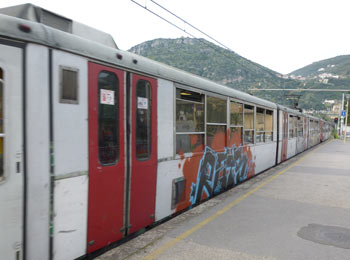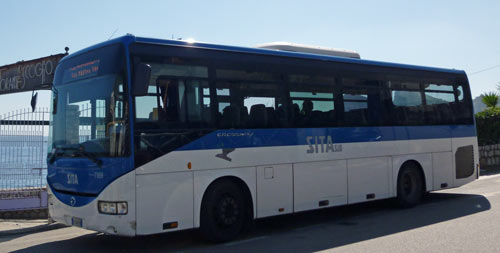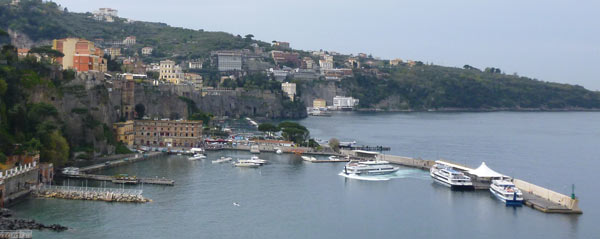Sorrento guide
Naples airport to Sorrento
One of the reason’s for Sorrento’s long-lasting popularity is that the resort is easy to get to. The nearest airport to Sorrento is Naples Airport, called Napoli Capodichino (NAP). This is served by British Airways flights from London Gatwick at the time of writing. Scheduled flights from the UK and Ireland are also operated by Easyjet (from Edinburgh, Stansted, Gatwick, Liverpool), Meridiana (Gatwick), Aer Lingus (Dublin) and Monarch (Leeds Bradford), as well as charter flights for package holidays. Flights vary considerably in availability and price throughout the year. Generally scheduled airlines are more reliable and fly at more sociable hours than charter flights operated by holiday companies, although the latter maybe a practical option if they depart from your local airport. If you’re planning a special holiday it’s worth checking the prices of BA’s Club Europe tickets.
A direct airport bus service from Naples Airport to Sorrento runs every one to two hours (seasonal variations), operated by Curreri Viaggi (see links panel right). The bus leaves from outside the airport, opposite Departures – from Arrivals, turn left and walk along inside the terminal before exiting, or go straight outside and walk to the left. The journey is scheduled to take an hour and fifteen minutes, though this is traffic-dependent and at busy times may take much longer (at Easter I had a journey of nearly three hours). The bus stops in modern Pompei, Vico Equense, Sant’Agnello and the other towns en route, finishing up by the railway station in Sorrento, a few minutes walk from Piazza Tasso. You can buy your ticket from the driver, or book online in advance.
An alternative to the direct bus is to catch the airport bus (Alibus) into Naples. You can alight at Piazza Garibaldi and catch the Circumvesuviana or Campania Express train to Sorrento, or you could stay on the Alibus until it reaches the port, then catch a ferry to Sorrento. There is more on these modes of transport below. Make sure you check timetables in advance.
Sorrento by train
Sorrento isn’t on Italy’s national rail network, but it’s on a private commuter line and easily accessible from other parts of Italy. The most convenient mainline station to arrive at is Naples Stazione Centrale. Below the mainline railway station you will find the Circumvesuviana station. This is a metropolitan railway service which runs from Naples to Sorrento, stopping at many smaller stations along the way, including Pompeii and Herculaneum. It’s not a particularly comfortable journey; it’s a crowded commuter service with hard plastic seats. From Stazione Centrale to Sorrento the journey takes just over an hour. The trains run every half-hour, with a few gaps on Sundays and public holidays. A new and expensive alternative is the Campania Express, which is aimed at tourists, more comfortable and much quicker as it only stops at the ‘touristy’ stations.

Travel to Sorrento from Rome
If you are travelling from Rome, there are frequent trains running to Naples, with journey length and price varying depending on what type of train you take (journeys generally take under 2 hours). An efficient and economical alternative is to take a bus all the way to Sorrento. A company called Marozzi runs a service from Tiburtina Station in Rome to Sorrento, setting passengers down right by Piazza Tasso – ideal if you don’t fancy changing trains or carrying your luggage around. Tickets are reasonably-priced, and can be bought online. Timetables vary according to season and day of the week; there is generally an early-morning service and an afternoon service at weekends. You should confirm in advance. Journey time is approximately 4 hours, with one rest stop. The buses also stop at the Naples Beverello port, Pompeii ruins, Castellamare and Vico Equense.
Local transport in and around Sorrento
The historic centre of Sorrento can be toured on foot. In fact, since much of it is narrow pedestrian lanes, that is the only way to explore thoroughly. For a sightseeing tour (though obviously not down the lanes) there are various options for tourists including a mini-train, a ‘tram’, and horse-drawn carriages.
Most of the hotels in the area aren’t in the historic centre but spread over the hillside and along the coast. Larger hotels outside town may offer a shuttle service into the centre for their guests. Holiday-makers staying in the adjacent resorts of Sant’Agnello, Piano di Sorrento and Meta di Sorrento may find the Circumvesuviana train a quick way to travel; although it is a long walk inland from the coast and buses are likely to be more convenient. The best thing to do is check with your accommodation.
Local buses serve Sorrento and the nearby settlements and coast. Run by EAV, these services circle the urban area between Meta and Sorrento, and connect the centre of Sorrento (Piazza Tasso) with Marina Piccola and Marina Grande. One of the EAV services runs all the way along the coast from Meta through Sorrento to Massa Lubrense, running approximately every 20 minutes, which is a useful route for an excursion.
Linea A: Massa Lubrense – Capo di Sorrento – Piazza Tasso – Sant’Agnello – Piano di Sorrento – Meta
Linea B: Circular: Piazza Tasso – Marina Piccola (port) – Circumvesuviana station
Linea C: Piano – Sant’Agnello – Marina Piccola (port)
Linea D: Circular: Piazza Tasso – Marina Grande
Linea E: Sorrento circular.
Another bus company, Sitasud, runs services further afield, to Amalfi, Positano, Marina del Cantone and other villages on the peninsula. For some routes – e.g. to Massa Lubrense – passengers may have a choice between Sitasud and EAV services. However, note that at the time of writing the services issue different tickets, so you will need to plan ahead and purchase tickets for the right company, or carry a selection in your pocket. There used to be universal tickets around the Campania region, which made life much easier; where these exist they now cost more. Hopefully the arrangements will be re-organised.
Bus tickets are bought in advance, at tabacchi shops, and sometimes bars: look for the black and white ‘T’ sign outside or for signs advertising bus tickets (biglietti autobus). Not all tabacchi sell tickets, but those close to bus stops are likely to. You can buy single tickets for each leg of your journey; these are cheap and generally a standard price for Sorrento and all the outlying villages. It’s always a good idea to stock up on enough tickets for your return journey. More distant destinations cost more, and if you’re likely to be hopping on and off several times it might be worth purchasing a day ticket. Remember to specify what bus company and destination you want a ticket for. When you board a bus you are expected to validate your ticket with a date stamp in the machine provided. If it’s not working, let the driver know or write the date and time on the ticket in pen.

Ferries
Sorrento’s ferry port is at Marina Piccola, a small modern harbour at the foot of the cliffs near Piazza Tasso. The easiest way down for pedestrians is to catch the lift (1 euro) in the Villa Comunale park and then walk to the right along the sea. It’s also possible to walk down on foot from Piazza Tasso, or via steps from the Villa Comunale. One of the local EAV buses also connects other parts of Sorrento with Marina Piccola.
Scheduled ferry services are seasonal, and mostly cater for tourists planning day trips. The most frequent services are to the island of Capri and to Naples, with other ferries sailing around the peninsula to Positano and Amalfi, and occasional services to the island of Ischia. Ferry services are operated by several different companies, whose tickets can all be bought at a purpose-built row of desks down at Marina Piccola. Since the number of options may be confusing, it’s a good idea to check timetables and plan your trip in advance, maybe asking at your accommodation or the tourist office for any help you need. Note that most ferries are fast hydrofoil or catamaran services, which often don’t have an open deck. If enjoying a view or fresh air is important to you, ask about the type of boat before buying your ticket, and consider an organised excursion instead, which might take longer but offer a more scenic experience.
As an alternative to the scheduled passenger services, it’s possible to book on boat trips which will take you to a destination and back or cruise along the coast with breaks for swimming and lunch. If you’re travelling in a group, it could be a lot of fun to hire a boat with or without a skipper for a private excursion. Information on these options can be found at Marina Piccola and at tour agencies around Sorrento.

Travel tips
If you’re planning to use the public transport around Sorrento, I’d suggest researching and printing out a selection of useful timetables in advance, checking they are valid for the dates of your stay (links are provided on the right; orario means timetable). These will be very handy if you’re planning days out, or staying somewhere you’ll rely on buses. If you haven’t done this, pick some photocopies up at the tourist information office, or check free tourist magazines for timetables. Be aware that timetables vary by season and by weekday; they should have a key to specify. Feriali means Mondays-Saturdays. Festivi means Sundays and bank holidays. It may also be a good idea to stock up on bus tickets, so you can hop on and off buses at will.
Unfortunately transport services in the Naples area are run by a variety of different companies by public appointment. As concessions for routes change, companies appear and disappear and sometimes change their names. A lot of curious deals go on behind the scenes. Sometimes their former websites get taken over by commercial portals or dodgier businesses. If you have trouble finding up-to-date timetables or information online, I’d recommend consulting your hotel or the tourist information office.
On this site
Useful links
Sorrento hotels, B&Bs & apartments
Ferries